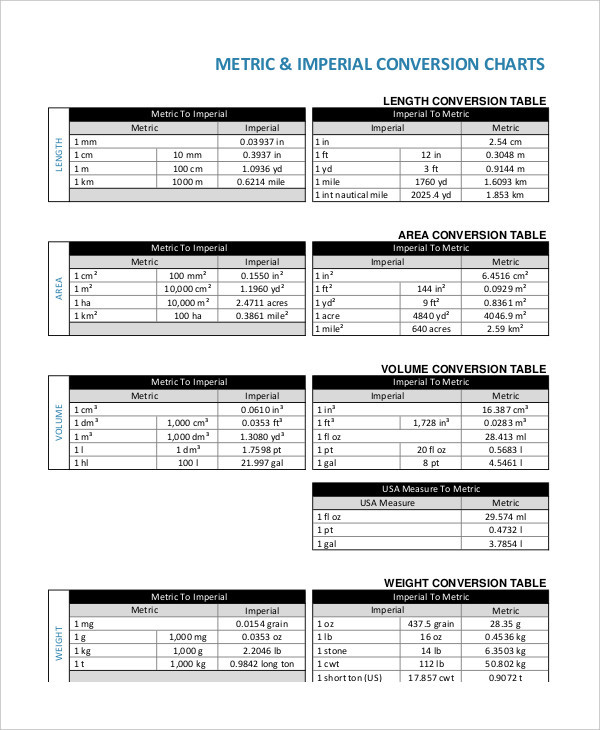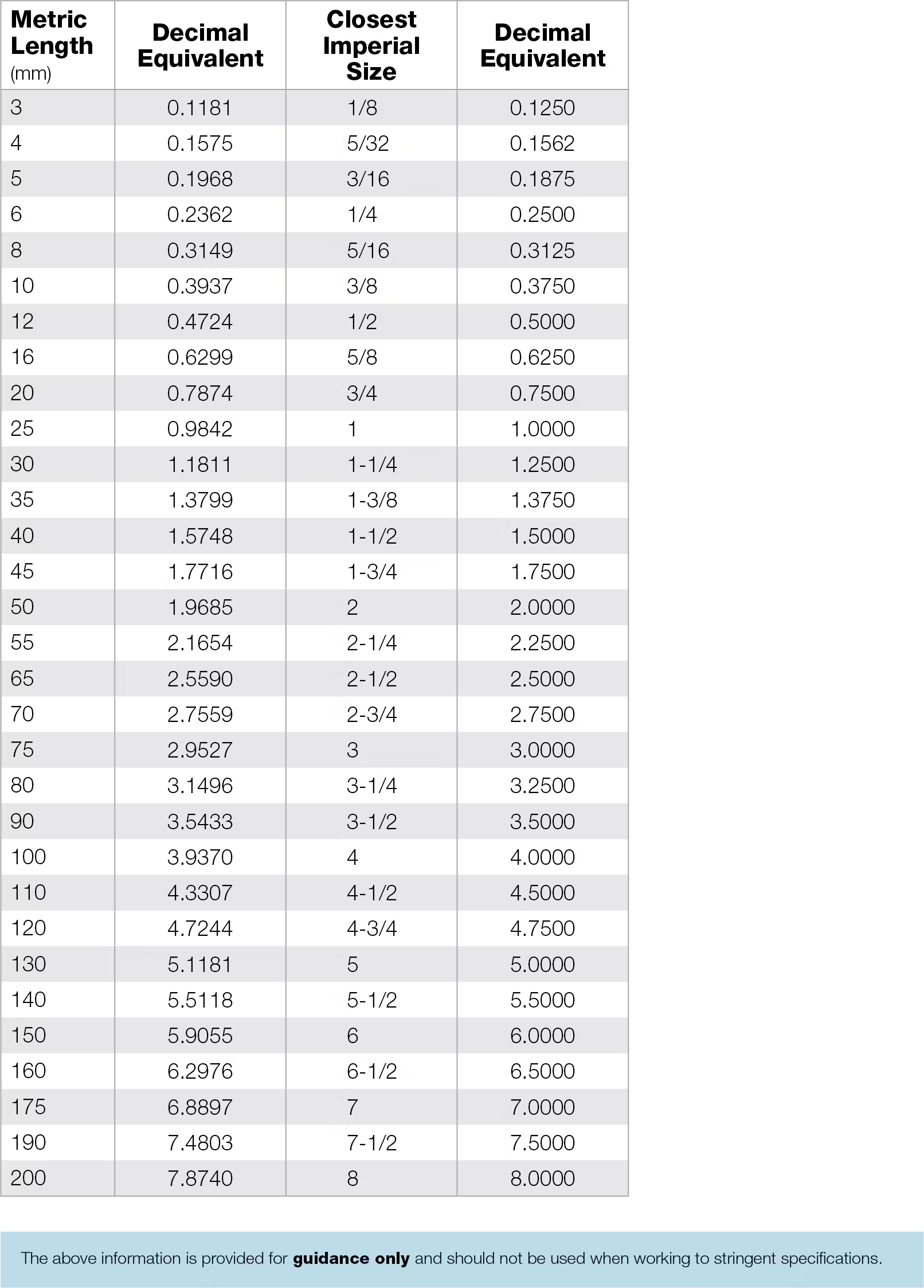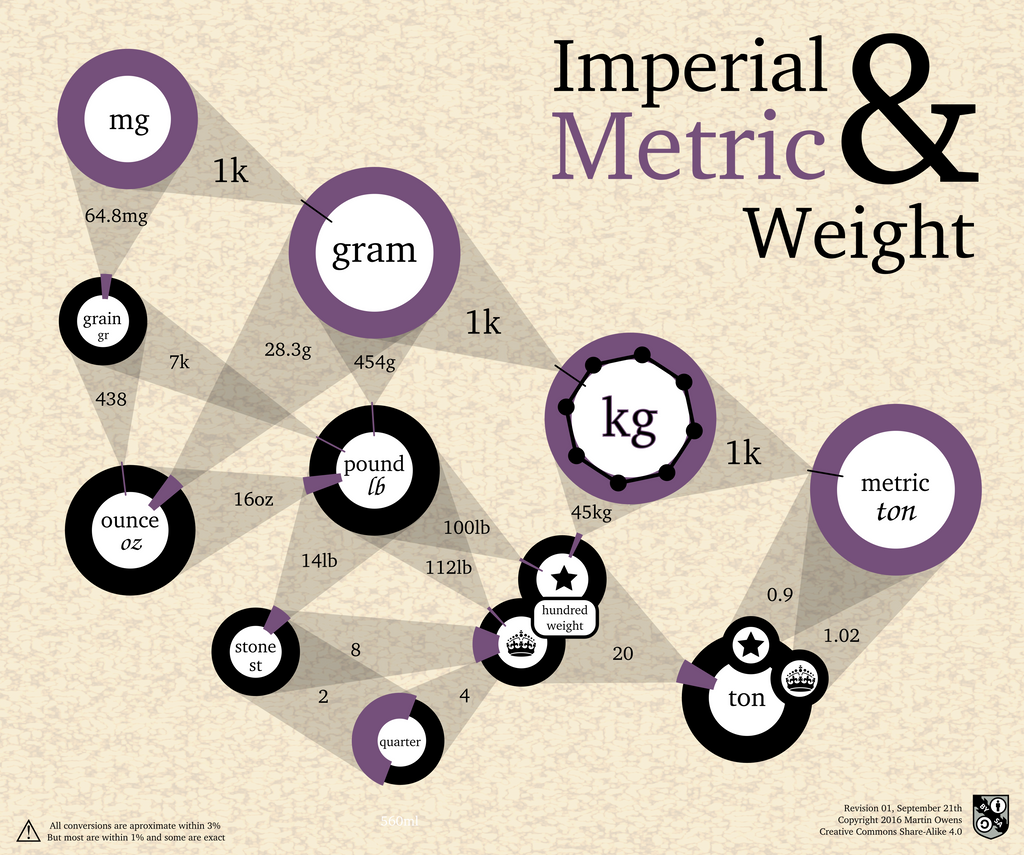
Imperial System Units, Comparison, Chart, Examples
The imperial system of units, imperial system or imperial units (also known as British Imperial [1] or Exchequer Standards of 1826) is the system of units first defined in the British Weights and Measures Act 1824 and continued to be developed through a series of Weights and Measures Acts and amendments.

Metric and Imperial Measures, Temperatures Vocabulary Home
The metric system also provides a convenient way to convert between different units of weight. For instance, to convert from grams to kilograms, one simply needs to divide the number of grams by 1000. Similarly, to convert from kilograms to grams, one multiplies the number of kilograms by 1000. This ease of conversion makes the metric system.

8+ Metric Weight Conversion Chart Templates Free Sample, Example, Format
Measurement conversion charts and converters for metric, imperial and United States Customary systems. Includes from everyday use to scientific calculators, thousands of units, definitions, abbreviations and formulas. Choose from wide variety of unit conversion tools and conversion charts for fast lookup.

Imperial Metric Conversion
What Is the Imperial System? The British Imperial System was the official system of weights and measures in the United Kingdom from 1824 until they adopted the metric system in 1965. The Imperial system standardized measurements for units like pound and foot that had different meanings in different places.

Metric to Imperial Conversion Chart Edit, Fill, Sign Online Handypdf
Problems on Metric And Imperial Conversions. 1) Convert 50 inches to meters. Ans: 1 inch is equal to 0.0254 m. Therefore 50 inch will be equal to 50 * 0.0254 = 1.27 m. 2) Convert 20 meters to the yard. Ans: We know that 1 yard is equal to 0.9144 m. So, 1 meter will be equal to 1/0.9144= 1.09361. Therefore 20 meters will be equal to 20*1.09361.

Metric to Imperial Conversion Chart Anzor
Imperial units, units of measurement of the British Imperial System, the official system of weights and measures used in Great Britain from 1824 until the adoption of the metric system in 1965. The U.S. Customary System of weights and measures is derived from it. Imperial units are now legally defined in metric terms.

Conversion Chart Imperial To Metric Printable Chart Chart Walls
The imperial system and the metric system are two different measurement systems for things like distances, volumes, and weights. Since all countries in the world don't use the same measurement system, it's important to understand both. What Is the Metric System? The metric system is defined as:

Imperialmetric recipe conversion table Cooking measurements, Cake sizes and servings, Recipe
By 1920, the percentage of the world's population using the imperial system or the US customary system was ~22%, with 25% using mainly the metric system, and 53% using neither. The International System of Units, currently the most widely used system of measurement, was published in 1960.

Metric and Imperial Weights Graph by doctormo on DeviantArt
Imperial and metric measurements Downloadable Worksheets More from Skillswise Weight is a measure of how heavy something is. A millilitre is the volume of one cubic centimetre. A thousand.

Metric and Imperial Lengths Graph by doctormo on DeviantArt
The imperial system of measurement or the British imperial system is the system of measurement defined in the UK after the Weights and Measures Act of 1824 and 1878. These include units that were in common use in Britain like inches, pounds, gallons, etc. Let us learn more about the imperial system in this article. What is Imperial System?

Metric to Imperial Chart Suffolk Fasteners, Ipswich Metric to imperial, Chart, Metric
Use this imperial to metric converter to easily convert between imperial and metric units for length measurement such as those used to measure dimensions and distance. Convert feet to meters, yards to meters, miles to kilometers, inches to centimeters, and more. Quick navigation: What units are supported? Imperial vs. Metric units of length

06.05.20 Year 6 Maths converting imperial & metric measures YouTube
To calculate the conversion of imperial units for length, area and volume, follow these simple steps: Remember the conversion of imperial units for the length: 1 mi = 1,760 yd. 1 yd = 3 ft; 1 ft = 12 in. To convert between surface imperial measurement units, use the square of the corresponding conversion factors for length (for example, 1 ft².

Printable Metric Conversion Chart
With the metric system, it's quick and easy to convert one unit to another by multiplying or dividing by powers of 10. Here's how it works — 10 millimeters is 1 centimeter and 10 centimeters.

Handy conversion table to help with those metric vs imperial conversions. Africa infographic
Length: 1cm = 10mm, 1m = 100cm and 1km = 1000m Whether you choose to use imperial or metric units of measure will depend on your task, and it is also possible to make comparisons between both.

Metric and Imperial Measures Tutorial YouTube
Measurement conversion calculator for metric and imperial units including Kilometers, Meters, Centimeters, Millimeters, Miles, Yards, Feet, Inches and Micron

Ultimate Kitchen Cheat Sheet for Imperial to Metric Conversion Daniel Scott Kitchens Kitchen
Metric converter for many metric and imperial units of temperature, weight, length, area and volume. Language. Metric Converter.. Whilst every effort has been made to ensure the accuracy of the metric calculators and charts given on this site, we cannot make a guarantee or be held responsible for any errors that have been made..